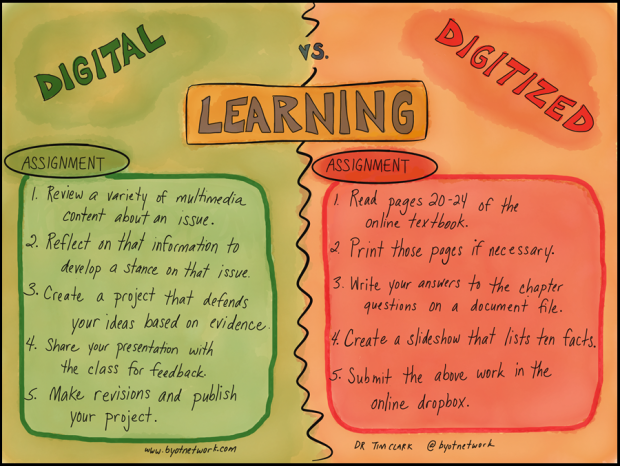
As teachers begin to shift toward greater personalized learning experiences for students, their initial steps build upon what they already know from face-to-face instruction. Districts usually provide teachers with easy to use Learning Management Systems (LMS) that can facilitate new learning opportunities with technology. However, the greatest potential of learning with technology tools is that teachers and students can transform the traditional learning environment, processes, and products. Just providing teachers with an organizational tool, such as an LMS, will not lead to transformative practices. Teachers need on-going support if they are to truly transform their classrooms into ecosystems for digital age learning.
A Model for Redefining Learning
The SAMR Model developed by Dr. Ruben Puentedura provides a guideline for explaining the digital transformation. The four levels within this model are Substitution, Augmentation, Modification, and Redefinition. At the Substitution level, teachers merely replace the traditional methods of instruction with digital tools, so instead of reading a printed textbook, the students are printing out their own pages from an online textbook. Instruction is at the Augmentation level when the use of technology benefits a commonly performed task, such as, having students submit their work within an online dropbox instead of having to turn papers in to their teacher in the classroom. At the Modification level, there is a significant change between what happen’s in the traditional face-to-face classroom and the digital age learning ecosystem. An example of this type of instruction is to design an authentic project and to share it in order to receive immediate feedback from others. Finally, instruction reaches the level of Redefinition when something is created that could not exist without the use of technology tools, resources, and access. Furthermore, the ideas and products are also student-generated.
Digitized Learning
Digitized learning encompasses the first two levels of the SAMR Model – Substitution and Augmentation. Compare the Assignments in the above illustration. The Digitized Learning Assignment has the students reading from an online textbook instead of a printed textbook. Rather than writing answers to the chapter questions on paper, the students are writing answers in a document file on a computer. They are told exactly what to create for their end product – a slide show that lists facts of information. Then they are submitting these products within an online dropbox. There are some benefits to this instruction. Namely, all of the student work can be organized online, and they can access the required information and complete the Assignment asynchronously. However, the level of instruction involved requires no creativity or critical thinking.
Digital Learning
To prepare students for an ever-increasing digital world, they need to engage in robust digital learning experiences. In the Digital Learning Assignment in the above illustration, the students are reviewing a variety of multimedia content so that they can learn from multiple resources and points of view. They are asked to reflect on that information to develop an opinion and to create a product that defends their opinions based on evidence. This requires a high level of critical thinking. They have to share their product for feedback and to incorporate that feedback into a finished, published version of their project – providing them with a more authentic audience for their endeavors. By focusing on this type of assignment, the digital learning is more likely to reach the Modification or the Redefinition levels of instruction.
Next Steps…
Review some of the learning experiences that your are providing for your students that involve technology. Consider what level of the SAMR Model are you addressing with your instructional tasks. One simple way of moving to more truly digital learning experiences, instead of solely digitizing learning, is to provide open-ended assignments that encourage students to make choices. Until they have more practice and experience, students often prefer digitized learning activities because they require less effort, and we have taught them how to succeed by following basic directions. Districts and schools can assist teachers by providing the necessary digital resources, a sustainable digital curriculum, consistent professional learning, and achievable expectations. Likewise, multiple opportunities for on-going feedback, support, and collaboration with a variety of digital tools and content can help your students become effective and creative digital learners.
#1 by deadhead1155 on September 9, 2015 - 9:09 pm
Reblogged this on EYES OF THE WORLD.
#2 by Kristina Boutilier on October 12, 2015 - 2:13 pm
Hi Tim,
Great post!
I am hoping to use your image in my blog post as part of my reflection for my Media Literacy class. Would this be alright? I will not alter image and will source.
Thanks,
Kristina
#3 by BYOT Network on October 12, 2015 - 4:44 pm
That’s great, Kristina! I was responding and I saw you published the post. Thanks for giving me the credit for the illustration!
#4 by Jo Paget on October 28, 2015 - 11:16 am
Hi Tim,
We are using the SAMR model to refer back to when planning to ensure we are working above the line.
#5 by BYOT Network on October 30, 2015 - 8:21 am
That’s great, Jo. SAMR is a good way to reflect about technology use within your school and classroom.
#6 by debbiediscovers on October 29, 2015 - 7:19 pm
Reblogged this on Little Coders.
#7 by Kim on January 15, 2016 - 8:22 pm
Hi, love your blog post. I have used it in professional development with teachers in a workshop I designed on redefinition. I am writing a book on technology and assessment information and would like to know if I could please include your graphic – full credit of course. Thanks, Kim Meldrum @meldrumkim
#8 by BYOT Network on January 18, 2016 - 7:49 am
Hi Kim – Thanks for the compliment! Feel free to use the illustration along with providing credit. Let me know if you have any questions.
#9 by franktudela on June 20, 2016 - 4:50 pm
Reblogged this on CSantaAna in English.